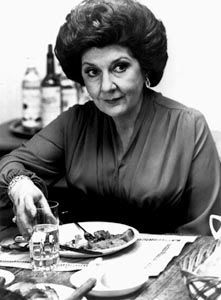So without further ado, it's time for the second installment in StinkyLulu's Supporting Actress Sundays: Maureen Stapleton in Woody Allen's Interiors.

Interiors is one of those movies that's nearly too excruciating to watch, but remains endlessly fascinating to contemplate. Sorta like a soap opera for folks in therapy. It's barely a surprise that Joel Schumacher did the costumes for this flick (his directorial oeuvre suggests anything but subtlety) -- it's prolly his handiwork that makes Interiors one of those pictures where pretty much everything you need to know about a female character is conveyed by a quick glance at her hairdo.

Geraldine Page as Eve, the mother = severe topknot.
The sisters = Frizzy, Blunt, & Feathered, or Diane Keaton (Renata), MaryBeth Hurt (Joey) and Kristin Griffin (Flyn) respectively.
Finally, Maureen Stapleton as Pearl, the stepmother = Hot Roller.

Again, Maureen Stapleton sticks out like a sore thumb. But, here, that’s the point of the character. Woody Allen’s only tragedy, Interiors is rightly alleged to be an homage to Bergman, what with the the assemblage of contrasting female protagonists, the conspicuous use of mirrors and window panes, and the preciously posed profiles. To StinkyLulu's mind, though, Interiors is most interesting as a study of both structure and character that clears the forest for the genius of Hannah And Her Sisters (1986). But Hannah And Her Sisters derives from a palpably Chekhovian dramatic sensibility (an architecturally configured universe of characters, all impassioned mediocrities, who stagger around and occasionally bump into each other). Interiors, on the other hand, becomes more Strindbergian, a dramatic world in which even the arbitrary intimacies of life bear jagged edges. In Chekhov, it's a sport of survival and stamina even amidst the soulcrushing disappointment; in Strindberg, the mere fact of human connection effects spiritual violence.
In Interiors, Allen's characters turn tragic, in an epic fashion. Geraldine Page's Eve emerges as the voracious Medea-mother, sacrificing her children, devouring them for the lost love of of their father. In comic contrast, Maureen Stapleton’s Pearl blows into this family -- like the proverbial bull in a china shop, even destroying some heirloom crockery along the way. The contrast of Page/Eve and Stapleton/Pearl is stark. Sarah Vowell describes it this way:
“Geraldine Page is all beige this and bland that so her husband divorces her and hooks up with noisy, klutzy Maureen Stapleton, who laughs too loud and smashes pottery and wears a blood red dress to symbolize that she is Alive, Capital A." (Assassination Vacation, 5)
Geraldine Page (who got a Best Actress nom for her Eve) seems oddly miscast here. Sure, she’s doing her patented shtik – the one where she bravely puts forth a mask which is working less and less, and from behind which she peeks with intermittent ferocity. And, to be sure, it can be thrilling to see those ugly emotions lash out from behind those imperfectly maintained façades… Yet, as always, Page's performance seems to dissemble the very illusions that her character needs for her very survival.
Strangely, though, it's Stapleton's performance of a loose sloppy woman that emerges as a marvel of precision and, once again, Stapleton's immediate palpable presentness anchors Pearl as an indelibly Stapleton character. Indeed, Stapleton's Pearl blows like a hurricane into this family of the walking wounded. (See, each of the girls -- Frizzy, Feathered, & Blunt -- is nursing her wounds, as evidence of a lifetime of slights and disappointments.) Maureen Stapleton’s Pearl, on the other hand, is a creature who doesn’t need to be right. And while Pearl can so clearly be hurt (remember Stapleton's stricken expression when Mary Beth Hurt's Joey shreiks and calls her an animal), Stapleton's Pearl provides proof positive of the possibility of healing. And that astonishing fact of life fully-lived tosses the whole family into a fresh disequilibrium.
StinkyLulu's rushing now...
But it's a powerhouse performance, Stapleton's Pearl. And just as Pearl breathes life into a nearly drowned Joey, so too does Stapleton infuse this odd Woody Allen marvel with a profound and powerful force. That Maureen, she could be real good.

1 comment:
Lovely, although I don't feel the same way about Geraldine Page. And this movie is mostly excruciating to me in a "Will someone please tell a joke?" kind of way. But I love how everyone and everything is beige, beige, and beige, then Pearl walks in and is so RED. Like being hit over the head with a club--how can he be so subtle in his comedy and so obvious in his tragedies?--I guess there's more than a little Chekhov there.
Post a Comment